Humans are unique in their needs for order and meaningfulness. The granddaddy of all phenomena requiring meaningfulness is, of course, death. If death were understood to be an absolute end, many would find life devoid of meaning. Life would be futile if no matter how one lived on earth--whether one was evil or virtuous, selfish or altruistic--or what one achieved, the conclusion remained the same: total nothingness and extinction of the self.
 But humans generally have not accepted this perspective. And
throughout most of history, religion has been the social institution controlling
the rituals and knowledge associated with death. Its message has generally been
the same: life does not conclude with death, but rather one is resurrected,
reincarnated, absorbed into some collective oversoul, or moves on to some
heaven, hell, or world of shades. Among the evidence proffered, such as by
Catholicism and the Russian Orthodox Church, are the incorruptible
remains of saints. (A logic employed in the state-building of the only
known society to proclaim death's finality: the Russian's enshrinement of the
embalmed remains of Lenin. To establish eternal legitimacy the Communists
had to immortalize Lenin.) Immortality is also conferred through
collective memory, such as the canonization rituals of the Catholic church.
The Vatican under Pope John Paul II, for instance, has become a veritable saint
factory. By the middle of 2004, he had created 482 saints during his
25-year pontificate--compared with 300 created by all of his predecessors combined.
But humans generally have not accepted this perspective. And
throughout most of history, religion has been the social institution controlling
the rituals and knowledge associated with death. Its message has generally been
the same: life does not conclude with death, but rather one is resurrected,
reincarnated, absorbed into some collective oversoul, or moves on to some
heaven, hell, or world of shades. Among the evidence proffered, such as by
Catholicism and the Russian Orthodox Church, are the incorruptible
remains of saints. (A logic employed in the state-building of the only
known society to proclaim death's finality: the Russian's enshrinement of the
embalmed remains of Lenin. To establish eternal legitimacy the Communists
had to immortalize Lenin.) Immortality is also conferred through
collective memory, such as the canonization rituals of the Catholic church.
The Vatican under Pope John Paul II, for instance, has become a veritable saint
factory. By the middle of 2004, he had created 482 saints during his
25-year pontificate--compared with 300 created by all of his predecessors combined.
 Such consolations, however, carry a price. By creating
and maintaining anxieties related to death (e.g., being consigned to hell
instead of heaven, or being forced to go through another round of reincarnation
instead of reaching nirvana) and the nature of one's immortality, religion
developed perhaps the most effective mechanism of social control ever devised.
Consider how many generations have lived their lives in the complete certainty
that they would have to face some sort of judgment after death, that their
every action was being observed by some grand evaluator. Click
here to see Americans' beliefs in the devil.
Such consolations, however, carry a price. By creating
and maintaining anxieties related to death (e.g., being consigned to hell
instead of heaven, or being forced to go through another round of reincarnation
instead of reaching nirvana) and the nature of one's immortality, religion
developed perhaps the most effective mechanism of social control ever devised.
Consider how many generations have lived their lives in the complete certainty
that they would have to face some sort of judgment after death, that their
every action was being observed by some grand evaluator. Click
here to see Americans' beliefs in the devil.
Religions' role in shaping death fears, funerary ritual, burial practices, and attitudes toward death-related moral issues remains considerable. For instance, the role of religious faith and religiosity in shaping Americans' attitudes toward euthanasia and abortion is at least as potent as any other influence, such as education and age.
With modernization and secularization, religion is losing its historic monopoly over death, most notably to the medical and legal institutions. As a result, death became transformed from being something natural and respected into something unnatural and polluting. And, according to Pope John Paul II, Western modernity has spawned a culture of death, evidenced by high rates of violence and abortion and growing acceptance of euthanasia.
Have you noticed how, like the early hunters and gatherers, surfers in cyberspace often return home with little to show for their browsings? Oh, maybe you captured a new background pattern here and a few new icons from there, but too often links lead to links and little more. In this medium it seems that people gravitate to the visual and auditory experiences that cannot be captured on the printed page. And who--particularly academicians and other idea-tinkerers--is really willing to put their "best stuff" out into this electronic Wild West where thievery runs rampant?
Well, I'm interested in seeing to what extent the Web can actually be used to create some good ideas and insight. Here I would like to share one of the topics that I am researching and invite you to participate in this inquiry. Any contributions that you make and that I include will certainly be given credit. Each week or so this work will be updated for those interested in following along.
In 1995, a Gallup poll found 65% of Americans believing in the Devil's existence, up 17% from 1974 and 28% from 1964 (when 37 percent so believed) according to national surveys by the Center for Policy Research. Gallup also found in 1995 that 28% of Americans believing in communication with the dead, up 10 points from 1990. Belief in reincarnation was up 6% during the first half of the 1990s.
What is to be made of such factoids? They could be several gauges of some Spiritual Dow Jones: Ghost movies are up 20 percent, channeling down 5 points, and the ratings for Nielsen for Psychic Network up .1. They certainly reflect the socio-cultural times: According to the 1974 study, six out of ten of those certain in the devil's existence expected social conditions to deteriorate, compared with only 23 percent of those not believing he exists. Here let us consider a related belief: expectations for an afterlife.
Consider the power of the idea that one's existence does not conclude with death. How different are the lives lived by those with complete certainty in a hereafter compared with those who live with equal conviction that death extinguishes all existence? Is it possible that this is a root idea lying at the very core of all cultural systems? That the directions civilizations evolve are, ultimately, based on their beliefs in and orientations toward life after death?
They who believe not shall have garments of fire fitted unto them; boiling water shall be poured on their heads; their bowels shall be dissolved thereby and also their skins, and they shall be beaten with maces of iron.
--Koran
In addition to being a death-consoler, we must also observe the millions of individuals who have died in the name of religion. The Inquisition, for instance, and its divine mission to eliminate heretics, witches, Jews, alchemists and others opposed to Roman Catholicism remains seared in the collective memory of the West, as do other eras of religious persecution. More recently, the appearance of Comet Hale-Bopp in the Spring of 1997 prompted the collective suicide of 39 followers of the Kingdom of Heaven cult. This story rekindled memories of the 1978 mass suicide of over 900 followers of the Rev. Jim Jones and his People's Temple in the jungles of Guyana, the suicides of members of the Order of the Solar Temple, and the fiery demise of David Koresh and his Branch Davidian followers. And concurrent with these events, religion underlaid the malicious violence between Protestants and Catholics in Northern Ireland, between Hindus and Sikhs in India, Muslims and Jews in the Middle East, and between Christians and Muslims in Armenia, Azerbaijan, and the remnants of Tito's Yugloslavia.
A single death is a tragedy, a million deaths is a statistic.
--Joseph Stalin
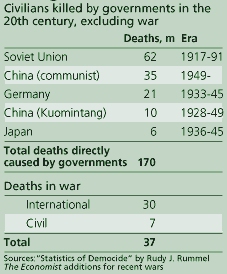 When one thinks about the connection between death and
political regimes, what comes to mind? The calculations
of atrocitologists of the those who perished in all the wars, massacres,
slaughters and oppressions of the Twentieth Century? Consider how national statistics
concerning life-expectancy
and standardized rates of infant and child
mortality, homicide, suicide, cancer deaths, and executions have come to be
viewed as international box scores. These death statistics measure not only
countries' levels of cultural and economic development, but also the adequacy
and legitimacy of their political regimes. Among the stories surfacing with the
fall of the Soviet bloc were reports of how East German physicians drowned very
premature babies in buckets of water and then officially recorded the deaths as
"abortions" (AP,1992). Der Spiegel claimed the reason was to
bolster East Germany's live birth statistics. In the United States in
2000, so glaring were racial differences that the Department of Human Health and
Human Services, in its Healthy
People 2010, set as a goal the elimination of racial and ethnic
disparities in illnesses. The report details how, when compared to whites,
blacks have death rates 40% higher due to heart disease, 30% higher due to
cancer (100% greater in the case of prostate cancer), and seven times higher due
to AIDS.
When one thinks about the connection between death and
political regimes, what comes to mind? The calculations
of atrocitologists of the those who perished in all the wars, massacres,
slaughters and oppressions of the Twentieth Century? Consider how national statistics
concerning life-expectancy
and standardized rates of infant and child
mortality, homicide, suicide, cancer deaths, and executions have come to be
viewed as international box scores. These death statistics measure not only
countries' levels of cultural and economic development, but also the adequacy
and legitimacy of their political regimes. Among the stories surfacing with the
fall of the Soviet bloc were reports of how East German physicians drowned very
premature babies in buckets of water and then officially recorded the deaths as
"abortions" (AP,1992). Der Spiegel claimed the reason was to
bolster East Germany's live birth statistics. In the United States in
2000, so glaring were racial differences that the Department of Human Health and
Human Services, in its Healthy
People 2010, set as a goal the elimination of racial and ethnic
disparities in illnesses. The report details how, when compared to whites,
blacks have death rates 40% higher due to heart disease, 30% higher due to
cancer (100% greater in the case of prostate cancer), and seven times higher due
to AIDS.
 Exploring the politics of death further in the United
States, to take just one year at random, consider
the lessons of 1993: the burning of the Waco, Texas compound of the Branch
Davidian cult; the dedication of the United States Holocaust Museum in
Washington, D.C.; and heated Congressional debates over American intervention
in the civil war in former Yugoslavia, allowing women to serve in military
combat roles, and a federal health-care system. Though apparently coincidental,
what was publicly dramatized was the ascendancy of civil religion over
all matters of life and death. In Waco, the state reaffirmed its monopoly
over legitimate violence. In Washington, the state demonstrated its power
to rescue from oblivion the memories of the millions politically selected
to die. And in Congress, the state determined the degree that premature
deaths would occur due combat and disease.
Exploring the politics of death further in the United
States, to take just one year at random, consider
the lessons of 1993: the burning of the Waco, Texas compound of the Branch
Davidian cult; the dedication of the United States Holocaust Museum in
Washington, D.C.; and heated Congressional debates over American intervention
in the civil war in former Yugoslavia, allowing women to serve in military
combat roles, and a federal health-care system. Though apparently coincidental,
what was publicly dramatized was the ascendancy of civil religion over
all matters of life and death. In Waco, the state reaffirmed its monopoly
over legitimate violence. In Washington, the state demonstrated its power
to rescue from oblivion the memories of the millions politically selected
to die. And in Congress, the state determined the degree that premature
deaths would occur due combat and disease.
Well over one-half of the federal budget is devoted either to refining the instruments of death or death prevention, such as:

By deconstructing death into those things that kill us and then attempting their eradication, modern political systems have become the master agencies of social control. Some might argue that the spate of legislated warning labels and required safety measures (for instance, it is easy to envision the home of the future filled with state-required alarms for all kinds of life-threats: smoke detectors, radon detectors, burglar alarms, severe storm warning systems, earthquake warning systems, etc.) has led to the rise of humanitarian fascism.
 This ascendancy of the state as the most powerful social
agency against death has a host of implications. For thanatological determinists,
political structures of power are seen to ultimately be collective efforts
to control death, either unleashing it against one's enemies or harnessing
it at home. With modernization, most premature death occurs because of
man-made (hence avoidable) causes. Concurrently, and not unrelatedly, modern
political regimes became the social institution providing the cultural
rituals for death control and death transcendence. It is not so much Eisenhower's
military-industrial, but rather a medical-military-industrial complex
that has evolved as the skeletal structure of the social organism. During
the 1980s, military and health-care employment were the major sources of
job growth in the United States, creating one in four new jobs. It can
be argued that death beliefs and fears have become increasingly politicized,
replacing their traditional religious counterparts as mechanisms of social
control.
This ascendancy of the state as the most powerful social
agency against death has a host of implications. For thanatological determinists,
political structures of power are seen to ultimately be collective efforts
to control death, either unleashing it against one's enemies or harnessing
it at home. With modernization, most premature death occurs because of
man-made (hence avoidable) causes. Concurrently, and not unrelatedly, modern
political regimes became the social institution providing the cultural
rituals for death control and death transcendence. It is not so much Eisenhower's
military-industrial, but rather a medical-military-industrial complex
that has evolved as the skeletal structure of the social organism. During
the 1980s, military and health-care employment were the major sources of
job growth in the United States, creating one in four new jobs. It can
be argued that death beliefs and fears have become increasingly politicized,
replacing their traditional religious counterparts as mechanisms of social
control.
 Political regimes, like religions, confer immortality to the elect--and oblivion
to the despised. Through state-sponsored historical observations (i.e.,
the American Bicentennial), holidays (i.e., Memorial Day), Presidential
Proclamation Days, museums, postage stamps and currency,
monuments,
statues, names of
buildings and parks, national cemeteries, and bureaucratic archives, regimes
preserve the memories of dead citizens (even if their names are forgotten, as
with the Tomb of the Unknown Soldiers). Through political-legal control over
rules of inheritance, governments assist in the perpetuation of family names and
estates (even socialist regimes have always limited estate taxes).
Political regimes, like religions, confer immortality to the elect--and oblivion
to the despised. Through state-sponsored historical observations (i.e.,
the American Bicentennial), holidays (i.e., Memorial Day), Presidential
Proclamation Days, museums, postage stamps and currency,
monuments,
statues, names of
buildings and parks, national cemeteries, and bureaucratic archives, regimes
preserve the memories of dead citizens (even if their names are forgotten, as
with the Tomb of the Unknown Soldiers). Through political-legal control over
rules of inheritance, governments assist in the perpetuation of family names and
estates (even socialist regimes have always limited estate taxes).
 Ritual demonstrations of this immortality-bestowing power of political regimes
occur in communist and democratic states alike. In the United States, for
instance, there were publicized Congressional debates in the 1970s over the
restoration of citizenship to Robert E. Lee and Eugene V. Debs, and in the 1980s
over making Martin Luther King's birthday a political holy day. In the Soviet
Union during the 1980s, charges of treason were cleared against Bolshevik
revolutionaries executed during Stalin's purges, and Boris Pasternak was
posthumously reinstated into the Soviet Writers' Union. Immortality can also be
obliterated, as the memories of some are consigned to political purgatory. Such
was to be the fate of some of the leaders of the 1956 Hungarian revolution,
including former prime minister Imre Nagy, who, after being hanged and buried,
had their cemetery plots bulldozed and left unmarked by the Moscow-controlled
government in Budapest.
Ritual demonstrations of this immortality-bestowing power of political regimes
occur in communist and democratic states alike. In the United States, for
instance, there were publicized Congressional debates in the 1970s over the
restoration of citizenship to Robert E. Lee and Eugene V. Debs, and in the 1980s
over making Martin Luther King's birthday a political holy day. In the Soviet
Union during the 1980s, charges of treason were cleared against Bolshevik
revolutionaries executed during Stalin's purges, and Boris Pasternak was
posthumously reinstated into the Soviet Writers' Union. Immortality can also be
obliterated, as the memories of some are consigned to political purgatory. Such
was to be the fate of some of the leaders of the 1956 Hungarian revolution,
including former prime minister Imre Nagy, who, after being hanged and buried,
had their cemetery plots bulldozed and left unmarked by the Moscow-controlled
government in Budapest.


The first genocide of the twentieth century may have occurred between 1904-1907 when German soldiers almost eliminated the Herero tribe in what was then South West Africa (now central Namibia). In 1915, 1.5 million Armenians were slaughtered by Turks. Listen to the survivors. In the words of the U.S. ambassador to Turkey at the time, Henry Morgenthau, what took place was "a campaign of race extermination." These pogroms set the stage for many similar campaigns throughout the Twentieth Century, including:
Helen Fein observed in her 1992 book Genocide Watch that "no state has tried anyone for genocide under conditions affording adequate judicial safeguards and reference to provisions of the [1948 United Nations Genocide Convention]" (p.3).
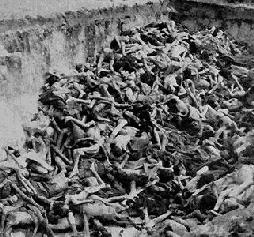
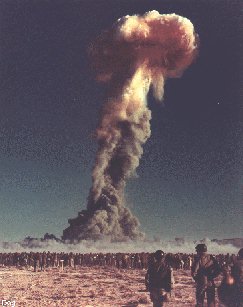 According to a 1995 study headed by John Pike, director of the Federation
of American Scientists' space policy project, the United States spent
about one-fourth to one-third of the entire military budget since 1945
on nuclear weapons. The annual cost of the maintenance and deployment of
the 8,750 operational weapons was estimated to be $25 billion a year. See
the
U.S.
Nuclear Weapons Cost Study Project for data on weapons history and
costs, published articles, and links to nuclear weapons sites.
According to a 1995 study headed by John Pike, director of the Federation
of American Scientists' space policy project, the United States spent
about one-fourth to one-third of the entire military budget since 1945
on nuclear weapons. The annual cost of the maintenance and deployment of
the 8,750 operational weapons was estimated to be $25 billion a year. See
the
U.S.
Nuclear Weapons Cost Study Project for data on weapons history and
costs, published articles, and links to nuclear weapons sites.
But the price is really much higher. In 1990, Energy Department officials reported that about 62 pounds of plutonium, enough for seven nuclear bombs, escaped into air ducts at the Rocky Flats weapons plant over the previous 30 years. A year later, it was reported that at the Hanford nuclear reservation in Washington, those rushing to build nuclear bombs during the 1940s and 1950s dumped millions of gallons of radioactive waste into ground. There during one episode in 1945, over one ton of radioactive material--about 375,000 curies of radiation--was released into the air. (Click here to see fallout rates in rads from 90 U.S. nuclear tests according to a National Cancer Institute study.) Since the early 1950s, bomb producers at the Soviet's Cheryabinsk weapons complex pumped over 120 million curies of waste--more than 2-1/2-times the radiation released at the 1986 Chernobyl accident--into a small 100-acre lake. Today, one standing at lakeside would receive a lethal dose of radiation within one hour.
 Federation
of American Scientists' The High Energy Weapons Archives: A Guide to Nuclear Weapons
Federation
of American Scientists' The High Energy Weapons Archives: A Guide to Nuclear Weapons

Despite the end of the Cold War, the weapons industry
 continues to flourish according to the U.S. Arms Control and Disarmament
Agency's "World
Military Expenditures and Arms Transfers," with the United States
spending one-third of the $864 billion spent worldwide in 1995. A
1997
survey by the Congressional Research Service, in 1996, revealed that
for the sixth consecutive year the United States led all nations in weapons
sales, receiving 35.5 percent of the $31.8 billion dollar global
arms market, up from 23% the year before.
continues to flourish according to the U.S. Arms Control and Disarmament
Agency's "World
Military Expenditures and Arms Transfers," with the United States
spending one-third of the $864 billion spent worldwide in 1995. A
1997
survey by the Congressional Research Service, in 1996, revealed that
for the sixth consecutive year the United States led all nations in weapons
sales, receiving 35.5 percent of the $31.8 billion dollar global
arms market, up from 23% the year before.
And precisely what is the military establishment dreaming up in this post 9-11 era?
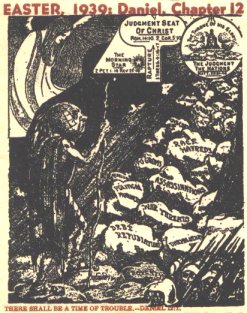
According to Valentin Tikhonov in Russia's Nuclear and Missile Complex: The Human Factor in Proliferation (2001, Carnegie Endowment for International Peace), working conditions and living standards for Russia's nuclear and missile experts have deteriorated precipitously in post-Communist Russia. Nearly two-thirds of these employees earn less than $50 per month and 58% are forced to work second jobs, making nearly irresistible the temptation to sell their expertise to nations aspiring to join the nuclear club.
A number of interesting sites have appeared dealing the the broad cultural impacts of nuclearism.
 As we
move through the conclusion of the military
century
it is worth reflecting on the human toll. Of all war fatalities over the past
500 years, fully three- quarters occurred during the past one hundred years. (Click
here for war links. For interactive time-lined maps of types of
conflicts and resultant casualties, see the Nobel
e-Museum's Conflict Map.) Four out of five Russian men born in 1923 were killed in World War II--a
conflict so devastating that fatalities are rounded off to the nearest million. For one case study of war's horrors check out Masato Kajimoto's The
Nanking Atrocities. For moving images, visit the Internet
Archive World at War collection.
As we
move through the conclusion of the military
century
it is worth reflecting on the human toll. Of all war fatalities over the past
500 years, fully three- quarters occurred during the past one hundred years. (Click
here for war links. For interactive time-lined maps of types of
conflicts and resultant casualties, see the Nobel
e-Museum's Conflict Map.) Four out of five Russian men born in 1923 were killed in World War II--a
conflict so devastating that fatalities are rounded off to the nearest million. For one case study of war's horrors check out Masato Kajimoto's The
Nanking Atrocities. For moving images, visit the Internet
Archive World at War collection.
Worldwide, for every dollar currently spent per pupil for education, twenty-five are spent per soldier. Click here for resources detailing America's military history. Try search engine SearchMil.com with "over 1 million military pages indexed and ranked in order of popularity." For information as to who has what military technology go to Jane's International Defence Directory. And for a history of ground rules for war on non-combatants see Gene Dannen's International Law on the Bombing of Civilians.
At of the beginning of the year 2000 there were 38 conflicts around the world that produced one thousand or more casualties, according to the Center for Defense Information's "The World At War". In 2005, according to GlobalSecurity.org, this number had declined to 8. From the CIA World Fact Book comes Disputes: International, detailing all current wars and territorial disputes.


![]() The winds of war are rapidly gathering strength following the deadly terrorist attacks on New York City and Washington, D.C. Bin
Laden seems to have a sensitivity to the calendrical significance of his acts of
terrorism. Apparently American authorities were able to thwart his plans for
Jan. 1, 2000. When wondering why September 11 my 13-year-old had an interesting
observation: "Dad, it's 911.
Nine-one-one has become the number associated with emergencies in this country.
Now, every time we dial it we may be reminded of its association with one of the
most horrific days in our country's history. The novelty of
21st-century conflict requires new lesson plans. For assistance with the
terminology check out the Global
Counterterrorism Glossaries. From Wadsworth comes Terrorism:
An Interdisciplinary Perspective.
The winds of war are rapidly gathering strength following the deadly terrorist attacks on New York City and Washington, D.C. Bin
Laden seems to have a sensitivity to the calendrical significance of his acts of
terrorism. Apparently American authorities were able to thwart his plans for
Jan. 1, 2000. When wondering why September 11 my 13-year-old had an interesting
observation: "Dad, it's 911.
Nine-one-one has become the number associated with emergencies in this country.
Now, every time we dial it we may be reminded of its association with one of the
most horrific days in our country's history. The novelty of
21st-century conflict requires new lesson plans. For assistance with the
terminology check out the Global
Counterterrorism Glossaries. From Wadsworth comes Terrorism:
An Interdisciplinary Perspective.
| Isn't it ironic? Since 1991, the Pentagon has banned the media from photographing the caskets of fallen warriors being returned home. Since 1992, the U.S. government has annually spent $100 million to locate and recover combatants' remains throughout the world. |
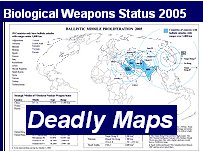 As America prepared for war against Iraq in 2003, Defense Secretary Donald Rumsfeld did not rule out
American use of nuclear weapons. Concurrently, North Korea was reactivating its nuclear program to reaffirm its membership
in the nuclear club with the U.S., Russia, Britain, France, China, Israel, India and Pakistan.
That same week in February, American intelligence revealed that North Korea had
a long-range missile capable of hitting the western U.S., and Iran's atomic
energy chief announced that his country had begun enriching uranium. The
nuclear genie seemed to have escaped from its bottle. In September of
2002, Turkish authorities seized 33 pounds of weapons-grade uranium hidden in a
taxi. The same year the Bulletin
of Atomic Scientists moved the hands of its doomsday clock from nine to
seven minutes before midnight.
As America prepared for war against Iraq in 2003, Defense Secretary Donald Rumsfeld did not rule out
American use of nuclear weapons. Concurrently, North Korea was reactivating its nuclear program to reaffirm its membership
in the nuclear club with the U.S., Russia, Britain, France, China, Israel, India and Pakistan.
That same week in February, American intelligence revealed that North Korea had
a long-range missile capable of hitting the western U.S., and Iran's atomic
energy chief announced that his country had begun enriching uranium. The
nuclear genie seemed to have escaped from its bottle. In September of
2002, Turkish authorities seized 33 pounds of weapons-grade uranium hidden in a
taxi. The same year the Bulletin
of Atomic Scientists moved the hands of its doomsday clock from nine to
seven minutes before midnight.
According to a Pentagon-commissioned report, "An Abrupt Climate Change Scenario and Its Implications for U.S. Security" (by Peter Schwartz and Doug Randall, October 2003), if global warming persists, 21st century wars will be based not on "survival rather than religion, ideology, or national honor." Mega-droughts will cause mass famine, mass migrations, and war. "Nations with the resources to do so may build virtual fortresses around their countries, preserving resources for themselves."

The raising of wages leads to overwork among the workers. The more they want to earn, the more they must sacrifice their time and perform slave labour in which their freedom is totally alienated. ...In so doing they shorten their lives.
...Thus, even in the state of society which is the most favorable to the worker, the inevitable result for the worker is overwork and premature death, reduction to a machine, enslavement to capital.
--Karl Marx. 1964. Early Writings. NY: McGraw-Hill, pp. 71,73
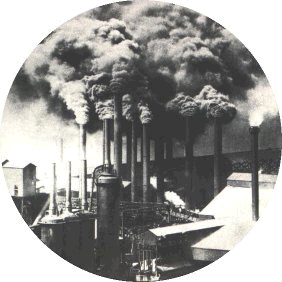 Folk songs of the "John Henry" genre reveal death's
intimate relationship with work. In 1979, the executive director of the Occupational Safety and Health Administration
(OSHA), Eula Bingham, noted that "A particular American form of suicide is
holding a steady job." Over the sixteen years that followed, over 88,000
civilian workers died from work-related injuries (see the CDC/MMWR report "Fatal
Occupational Injuries--U.S., 1980-1994", and click
here for an article on how American workplaces are among the deadliest in
the industrialized world). Capitalism kills.
At the beginning of the new century there were still more than 6,000 workplace
deaths due to traumatic injury, and an additional 50,000-60,000 more due to
"occupational diseases."
Folk songs of the "John Henry" genre reveal death's
intimate relationship with work. In 1979, the executive director of the Occupational Safety and Health Administration
(OSHA), Eula Bingham, noted that "A particular American form of suicide is
holding a steady job." Over the sixteen years that followed, over 88,000
civilian workers died from work-related injuries (see the CDC/MMWR report "Fatal
Occupational Injuries--U.S., 1980-1994", and click
here for an article on how American workplaces are among the deadliest in
the industrialized world). Capitalism kills.
At the beginning of the new century there were still more than 6,000 workplace
deaths due to traumatic injury, and an additional 50,000-60,000 more due to
"occupational diseases."
The most lethal occupations in the United States involve fishing and fish farming, whose 1996 fatality rate was 16 times higher than for firefighting and 40 times the national average. (Each year in 19th-century Gloucester, Massachusetts, about 200 fishermen would be lost at sea--about 4% of the town's population.) Despite solid criminal cases, in no instance has any employer who knowingly and willfully violated federal regulations which resulted in workers' deaths ever been imprisoned. It is cheaper for companies to allow their workers to be killed than to create safer working environments.
In the early 1980s, 69 epidemiological studies for the National Institute for Occupational Safety and Health (NIOSH) revealed one quarter of a million American workers were exposed to hazardous materials at 258 worksites. In 1983, the Institute with the Centers for Disease Control and Prevention concluded that NIOSH had a duty to inform such exposed workers "particularly when NIOSH is the exclusive holder of information and when there is clear evidence of a cause and effect relationship between exposure and health risk." Despite this recommendation, the Reagan administration refused to support a $4 million pilot notification program. By 1993, fewer than three out of ten exposed workers had been notified. (See 1999 Washington Post article "Uranium Plant Risks Were Concealed." For infamous story of the Radium Dial Company in Ottawa, Illinois, see the Museum of Atomic perMutation and the epidemiological studies of the Department of Energy.) In March 2004, the Environmental Working Group projected that more than 100,000 Americans will die over the following decade from four asbestos-related diseases: mesothelioma, asbestosis, lung cancer and gastrointestinal cancer. Such deaths, those due to exposure to hazardous substances, rarely are included in national tallies.
The lethal byproducts of the economic order are not confined to the workplace. In 2000, some 7.1 billion pounds of chemicals were released into the environment. Though down approximately 48% since 1988, this still meant more than 100 million pounds of carcinogens and a billion pounds of neurological toxicants were released into the nation's water, air and soil. A May 2002 report of the Environmental Protection Agency concluded that two-thirds of Americans, from all parts of the country, had elevated cancer risks because of 32 toxic chemicals that were studied. To view maps to see where the highest concentrations of these chemicals are go to the EPA's National-Scale Air Toxics Assessment and its Toxics Release Inventory Program. See also the 2003 report of the Public Interest Research Groups, "Toxic Releases and Health: A Review of Pollution Data and Current Knowledge on the Health Effects of Toxic Chemicals," which features state maps of releases of carcinogens, dioxins, and chemicals having deleterious neurological, reproductive, respiratory and developmental effects.
In a 1993 FBI report analyzing 1991 work-related fatalities in New York City found homicide to be the leading cause of death on the job. Although in its analysis of job-related fatalities in 32 states it found only 14 percent of workplace deaths were homicides, we hear more about workers "going postal." The National Institute for Occupational Safety and Health reported in 1997 that, on average, four workers are murdered each workday in the United States. Taxicab drivers have the highest risk of workplace homicide. A 1993 survey of women in the workplace found more secretaries were murdered on the job than police officers and bartenders combined. To follow studies of the phenomena, check out the Workplace Violence Research Institute.

The twentieth anniversary of the Bhopal disaster was observed throughout India. Union Carbide claims that 3,800 people were killed; while Indian officials estimates 15,000. Even if Union Carbide’s estimate is correct, that puts 12-03-84 for Indians on par with 9-11-01 for Americans.
There are those who deal directly with death, which brings a certain stigma within death-denying societies such as our own. In The Forbidden Zone (Farrar, Straus and Giroux, 1987), Michael Lesy interviews those from different levels in the hierarchy of death occupations: those at the bottom who slaughter animals, homicide detectives, forensic and medical pathologists, morticians, and, on the top, hospice workers. What insights about death do these death workers have? Listen to Lesy and some of these workers in NPR's "This Life" program "Business of Death" (aired March 18, 1997--RealPlayer required).
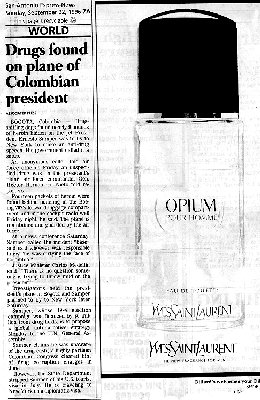 The juxtaposition of the newspaper article and the "Opium" cologne
ad on the right got me thinking about the ways in which capitalism uses
death to sell. In fact, I happened across the ad while watching the conclusion
of a PBS rerun of a twenty-year-old "Lawrence Welk Show," where
the two sponsors were a nursing home and a funeral home.
The juxtaposition of the newspaper article and the "Opium" cologne
ad on the right got me thinking about the ways in which capitalism uses
death to sell. In fact, I happened across the ad while watching the conclusion
of a PBS rerun of a twenty-year-old "Lawrence Welk Show," where
the two sponsors were a nursing home and a funeral home.
Consider the following marketing lessons:
 and Albert Einstein hawking cameras; the 1992 Olympics featured a Diet Coke ad
with Paula Abdul joking and dancing with Groucho Marx, and being poured a coke
by Cary Grant (Watching the dead peddle a soft drink reminded me of when the
makers of Pepsi-Cola moved into the Thai soft drink market. Their advertising
campaign initially used the American slogan, "Come alive, you're in the
Pepsi generation." Only later did the company realize that the Thai
translation it was using said, "Pepsi brings your ancestors back from the
dead." But the Thais had it right, except it's Diet Coke that is the
resurrection beverage.). The favorite agency of dead celebrities: the Curtis Management
Group; forthcoming: AdAgencyForTheDead.com.
and Albert Einstein hawking cameras; the 1992 Olympics featured a Diet Coke ad
with Paula Abdul joking and dancing with Groucho Marx, and being poured a coke
by Cary Grant (Watching the dead peddle a soft drink reminded me of when the
makers of Pepsi-Cola moved into the Thai soft drink market. Their advertising
campaign initially used the American slogan, "Come alive, you're in the
Pepsi generation." Only later did the company realize that the Thai
translation it was using said, "Pepsi brings your ancestors back from the
dead." But the Thais had it right, except it's Diet Coke that is the
resurrection beverage.). The favorite agency of dead celebrities: the Curtis Management
Group; forthcoming: AdAgencyForTheDead.com.  in Adweek (Southwest Edition, "What's New
Portfolio," vol. VI:52, Nov. 26: 37) appeared the insight: "For some
arcane reason, if you're in the business of creating TV commercials, funerals
are funny. So is the reading of last wills and testaments."
in Adweek (Southwest Edition, "What's New
Portfolio," vol. VI:52, Nov. 26: 37) appeared the insight: "For some
arcane reason, if you're in the business of creating TV commercials, funerals
are funny. So is the reading of last wills and testaments."
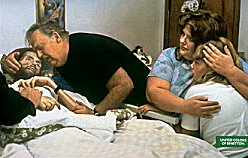 of Italian clothing marketer United
Colors of Benetton have pushed the proverbial envelope, featuring images (as
described in Wikipedia) "of
people dying of AIDS, panicking crowds jumping off of a sinking ship, ... and a
death row
inmate."
of Italian clothing marketer United
Colors of Benetton have pushed the proverbial envelope, featuring images (as
described in Wikipedia) "of
people dying of AIDS, panicking crowds jumping off of a sinking ship, ... and a
death row
inmate."
 The tobacco industry, of course, provides a rich case study
here. During the summer of 2001 Philip Morris commissioned a report (conducted
by Arthur D. Little International) for the Czech government wherein it was
argued that smokers saved the state millions of dollars by dying prematurely. How
does one go about marketing such a population-checking product line?
See Truth in Advertising: A
Collection of Vintage Cigarette Advertisements from the Age of Innocence.
The tobacco industry, of course, provides a rich case study
here. During the summer of 2001 Philip Morris commissioned a report (conducted
by Arthur D. Little International) for the Czech government wherein it was
argued that smokers saved the state millions of dollars by dying prematurely. How
does one go about marketing such a population-checking product line?
See Truth in Advertising: A
Collection of Vintage Cigarette Advertisements from the Age of Innocence.
 Hollywood has long known of audience attractions to
the erotic and the violent. According to Geoffrey Gorer in Death, Grief
and Mourning (1965), such seductions derive from cultural pruderies
toward matters of sex and death. And, as William May observed in "The
Sacral Power of Death in Contemporary Experience" (1973), as sex is
pornographic when divorced from its natural human emotions of love and
affection, so death becomes pornographic when divorced from its natural
emotion of grief. A new twist to pornographic death appeared on cable TV
in 2001 with HBO's "Six Feet
Under" drama series, whose website includes Autopsy
and an interactive movie on human
decomposition. Attracted to stories and images of celebrities
who have met the great leveler? Then Celebrity
Morgue is the place for you.
Hollywood has long known of audience attractions to
the erotic and the violent. According to Geoffrey Gorer in Death, Grief
and Mourning (1965), such seductions derive from cultural pruderies
toward matters of sex and death. And, as William May observed in "The
Sacral Power of Death in Contemporary Experience" (1973), as sex is
pornographic when divorced from its natural human emotions of love and
affection, so death becomes pornographic when divorced from its natural
emotion of grief. A new twist to pornographic death appeared on cable TV
in 2001 with HBO's "Six Feet
Under" drama series, whose website includes Autopsy
and an interactive movie on human
decomposition. Attracted to stories and images of celebrities
who have met the great leveler? Then Celebrity
Morgue is the place for you.
 As human death is typically hidden from everyday life,
to what extent are our death socializations and fears shaped by pornographic
death in the mass mediums of television, cinema, and music? Unlike the
contacts with real death in the past, media deaths generally do no generate
moral reflections and value crystallizations. Instead, according to media
critics, we become desensitized to death. Publicized box scores of holiday
fatalities on the nation's roads and death counts from accidents, wars,
or natural calamities become as meaningful as sports statistics.
As human death is typically hidden from everyday life,
to what extent are our death socializations and fears shaped by pornographic
death in the mass mediums of television, cinema, and music? Unlike the
contacts with real death in the past, media deaths generally do no generate
moral reflections and value crystallizations. Instead, according to media
critics, we become desensitized to death. Publicized box scores of holiday
fatalities on the nation's roads and death counts from accidents, wars,
or natural calamities become as meaningful as sports statistics.
And then, of course, there's the matter of the cultural impacts of media violence. According to a 1972 Surgeon General report, there is a causal relationship between make- believe television violence and the real thing. In the early 1990s, the American Psychological Association estimated that a typical American child will witness 8,000 murders and see 100,000 acts of violence on television before even finishing elementary school.
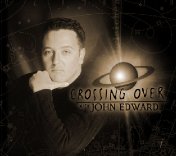
A post-millennium trend is the communion-with-the-dead genre of television programming. Channeling has come to mean more than station surfing. One no longer has to wait for a rare Shirley MacLaine special to hear about or witness séances. In the Spring of 2002, the SciFi channel renewed for another season the near-nightly program of John Edward, who “reunites people in the physical world with their loved ones who have crossed over.” At the same time, ABC Television, in the midst of a disastrous season with plummeting ratings, television aired in the Spring of 2002 a special “Contact: Talking to the Dead,” featuring a psychic’s interviews with deceased loved ones of Vanna White and Mackenzie Phillips as well as the murdered wife of Robert Blake.
On the other hand, there are signs of change, as when various medias truly attempt to tackle the challenges posed by dying and to provide empathetic insight into the worlds of the dying and their caretakers. Some examples:
As the century came to a close, another Hollywood death genre was being screened across the country: individuals' postmortem fates. In this contemporary updating of Paradise Lost, the past decade has featured such movies as --"All Dogs Go to Heaven" (1989), "Field of Dreams" (1989), "Always" (1989), "Ghost" (1990), "Ghost Dad" (1990), "City of Angels" (1998), "What Dreams May Come" (1998), "Meet Joe Black"(1998), "Jack Frost" (1999), "Sixth Sense" (1999), and "The Gift" (2000). Have you noticed a change in the role of the dead--how, instead of having adversarial relations with the living they now are more likely to assist them?
![]()